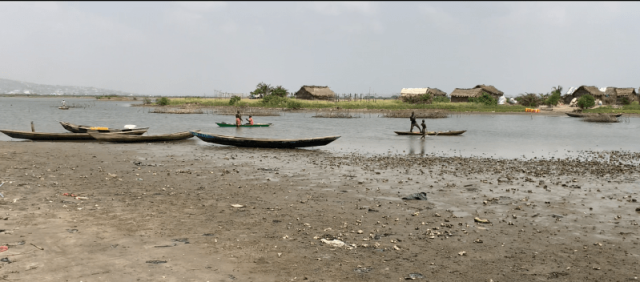By Rachel Kakraba
Faana, a community in the Ga South Municipality of the Greater Accra region, was brought to the limelight in May last year, following the drowning of some nine schoolchildren. It was an incident that attracted national attention and saw the plight of the students and the community gain some national attention. A year later, the news team was back in the community to ascertain how education had been picking up after the community was brought to its knees by the boat disaster.
The World Health Organisation (WHO), estimates that more than 236,000 people die annually from drowning. Drowning is among the leading causes of death for those aged one to 24 years and the third leading cause of injury deaths worldwide. In Ghana, a 2020 report on drowning by the WHO indicated approximately 740 drowning deaths, accounting for 0.42 percent of all deaths in the country. One of them that is still fresh in the minds of Ghanaians is the drowning incident that occurred at Faana-Botianor.
Life at Faana
Faana is an island community in the Greater Accra Region. It lies between the Sakumo River and the sea. It is a typical rural setting with thatch houses and settlers mainly engaged in fishing. The community lacks many social amenities, such as electricity, potable water, and a health post. It also lacks educational facilities; consequently, to access education, children are enrolled in schools in communities nearby, such as Tsokome, Botianor, Wiaboman and Dansoman, among others. Although this has been the norm for decades, disaster struck in May last year when a boat carrying schoolchildren returning from school capsized. The accident happened on the Wiaboman/Dansoman stretch, around the estuary. It was one that got both survivors, parents, and the entire community traumatized. The community received assurances of ensuring the safety of schoolchildren in the short term, but with a long-term plan.
Follow up on assurances
Months down the line, the news team was back at Faana to find out from residents whether all the promises and assurances received by the community had been fulfilled.
Azaay: “I have worked as a fisherman for more than 20 years. In the case of the children, they were on their own, hence the tragedy. I have indeed seen the boat, which was promised after the incident. It is on the Wiaboman side. It would have been convenient if it were two and also came with an outboard motor. In my view, it would be equally important for some stipends to be paid to the one manning the boat. With regard to the life jackets, they have also been provided.
Another fisherman, Sackey, said, “I usually come here to fish. It is very dangerous around this side because it is usually quiet; consequently, it is difficult to get assistance in the case of an accident. This is exactly what happened to the children. The boats have been provided, but not with outboard motors. The one who has volunteered to assist the children with the boat, I think, should be given some incentives.”

Daniel, a resident, said, “I have seen the boat, but without the engines. Life jackets have also been provided, though they are few. We have been assured we will be relocated, and we hope that it will be expedited because it is risky living here.”
Celestine: “At times, I wonder what time they will reach the school because the distance is too far. Most parents fear sending their children across the river to go to school, so we need a school in this town. I think if they can construct a bridge over the river too, we would appreciate it.”
Gabriel has lived in the community for more than twenty years; he also had this to say: “The life jackets have been provided. The canoe too we are having. They promised that they would give us Japan motors so that we would use it to paddle the canoe, but we are still using the stick to paddle it. And they said they would move us from this place to another place that is yet to be done. I want them to move us because we are suffering; besides, there’s no school here.”
Chief Agbesi Dodzegbe, an opinion leader in the community, said younger children who have reached school-going age are yet to be enrolled in schools due to the dangers involved in accessing schools in communities nearby.
“They promised they would provide us with water and light, as well as assist us to secure a land so that we can relocate; this is yet to be fulfilled. The MP has not visited again after the disaster. We received the canoe, but it didn’t come with an outboard motor. Some of the children have reached school going age but because of the dangers involved, they haven’t been enrolled in schools.”
It was early Wednesday morning, and the news team was on standby to find out how the students commuted to school. Students who commute from the Tsokome side still have to wait on the banks of the Sakumo River in order to be safely transported by canoes to the other side of the river.

The students contend they have to walk long distances from Faana in order to get access to school. As a result of the long-distance trekking, they usually make a stopover at a spot to put finishing touches on their look. All this is a reason most of them miss their first lessons.

Students who commute to and from Faana to access schools in communities nearby say they have to contend with walking long distances, which is a daunting task every school day. The students made an appeal.

“We use torchlights and phones to learn. Our handwriting is bad because we cannot see well. They should provide us with solar panels.”

“Please, we need water and light.”
“If they can put up a school here, it can also help because some children are not schooling.”

Spring Garden International School is one of the schools where these children access education. Proprietor of the school, Mr. Adama Stephen, acknowledged that students who commute from Faana usually report late to school as a result of the distance.
On whether the accident has impacted their academics, he said, “The few we have, after the incident, they still have been coming. It has not affected them academically much.”

Adding on, he said, “putting up a basic school in Faana will be very difficult because of where they are located, in between the sea and the river. So, all that I would suggest is that they should be provided with the necessary life jackets and other things. Things that will facilitate their in and out of school.”
Attempts to speak to some of the students who survived the boat accident proved futile as Auntie Maggie, a resident, told the news team that all the students had been relocated.
“As a result of the incident that happened here, parents have relocated their children. This is why you cannot spot any of them.”
Follow up with the Ga South Municipal Assembly
Faana falls within the Ga South municipality of the Greater Accra region; I therefore followed up on the issue at the assembly. Speaking off the record, a source told GBCGHANAONLINE that the report on the disaster is yet to be finalized.
Drowning is a significant public health challenge globally. In Africa, putting up a basic school in Faana will be very difficult because of where they are located, in between the sea and the river. So, all that I would suggest is that, uh, they should be provided with the necessary life jackets and other things.
Things that will facilitate their in- and out-of-school. And I believe that when that is done, they can come to school safely and go back safely. In Ghana, drowning remains a silent epidemic which calls for immediate attention.
















